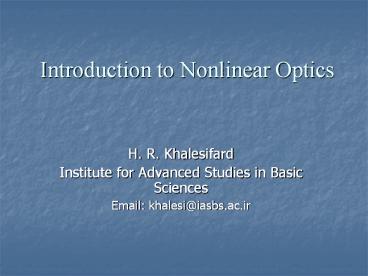Introduction to Nonlinear Optics
Title: Introduction to Nonlinear Optics
1
Introduction to Nonlinear Optics
- H. R. Khalesifard
- Institute for Advanced Studies in Basic Sciences
- Email khalesi_at_iasbs.ac.ir
2
Contents
- Introduction
- The essence of nonlinear optics
- Second order nonlinear phenomena
- Third order nonlinear phenomena
- Nonlinear optical materials
- Applications of nonlinear optics
3
Introduction
- Question
- Is it possible to change the color of a
monochromatic light? - Answer
- Not without a laser light
4
Stimulated emission, The MASER and The LASER
- (1916) The concept of stimulated emission Albert
Einstein - (1928) Observation of negative absorption or
stimulated emission near to resonant wavelengths,
Rudolf Walther Ladenburg - (1930) There is no need for a physical system to
always be in thermal equilibrium, Artur L.
Schawlow
5
(No Transcript)
6
LASER (MASER)
7
The Maser
- Two groups were working on Maser in 50s
- Alexander M. Prokhorov and Nikolai G. Bassov
(Lebedev institute of Moscow) - Charles H. Townes, James P. Gordon and Herbert J.
Zeiger (Colombia University)
8
- Left to right Prokhorov, Townes and Basov at
the Lebede institute (1964 Nobel prize in Physics
for developing the Maser-Laser principle)
9
- Townes (left) and Gordon (right) and the
ammonia maser they had built at Colombia
University
10
The LASER
- (1951) V. A. Fabrikant A method for the
application of electromagnetic radiation
(ultraviolet, visible, infrared, and radio
waves) patented in Soviet Union. - (1958) Townes and Arthur L. Schawlow, Infrared
and Optical Masers, Physical Review - (1958) Gordon Gould definition of Laser as
Light Amplification by Stimulated Emission of
Radiation - (1960) Schawlow and Townes
U. S. Patent
No. 2,929,922 - (1960) Theodore Maiman Invention of the first
Ruby Laser - (1960) Ali Javan The first He-Ne Laser
11
- Maiman and the first ruby laser
12
- Ali Javan and the first He-Ne Laser
13
Properties of Laser Beam
- A laser beam
- Is intense
- Is Coherent
- Has a very low divergence
- Can be compressed in time up to few femto second
14
Applications of Laser
- (1960s) A solution looking for a problem
- (Present time) Medicine, Research, Supermarkets,
Entertainment, Industry, Military, Communication,
Art, Information technology,
15
Start of Nonlinear Optics
- Nonlinear optics started by the discovery of
Second Harmonic generation shortly after
demonstration of the first laser. - (Peter Franken et al 1961)
16
2. The Essence of Nonlinear Optics
- When the intensity of the incident light to a
material system increases the response of medium
is no longer linear
17
Response of an optical Medium
- The response of an optical medium to the incident
electro magnetic field is the induced dipole
moments inside the medium
18
Nonlinear Susceptibility
Dipole moment per unit volume or polarization
- The general form of polarization
19
Nonlinear Polarization
- Permanent Polarization
- First order polarization
- Second order Polarization
- Third Order Polarization
20
How does optical nonlinearity appear
- The strength of the electric field of the
light wave should be in the range of atomic fields
21
Nonlinear Optical Interactions
- The E-field of a laser beam
- 2nd order nonlinear polarization
22
2nd Order Nonlinearities
- The incident optical field
- Nonlinear polarization contains the following
terms
23
Sum Frequency Generation
Application Tunable radiation in the UV
Spectral region.
24
Difference Frequency Generation
25
Phase Matching
- Since the optical (NLO) media are dispersive,
- The fundamental and the harmonic signals have
- different propagation speeds inside the media.
- The harmonic signals generated at different
points - interfere destructively with each other.
26
SHG Experiments
- We can use a resonator to increase the efficiency
of SHG.
27
(No Transcript)
28
What is the phase conjugation
The signal wave
The phase conjugated wave































